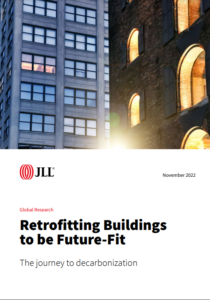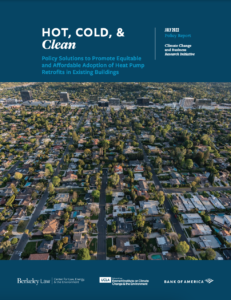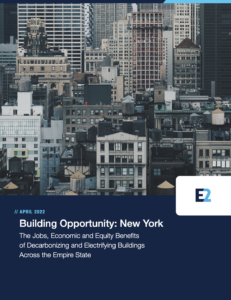The OurEnergyLibrary aggregates and indexes publicly available fact sheets, journal articles, reports, studies, and other publications on U.S. energy topics. It is updated every week to include the most recent energy resources from academia, government, industry, non-profits, think tanks, and trade associations. Suggest a resource by emailing us at info@ourenergypolicy.org.
Resource Library
51 to 60 of 343 item(s) were returned.
Globally, the real estate industry is facing an enormous challenge: retrofitting our buildings to reduce global carbon emissions. It is time for those leading the industry, along with governments, to drive the asset transformation needed. JLL estimates that US$3 trillion will be required to meet these retrofitting targets. Addressing the knowledge gap, upskilling the workforce and scaling technology will be critical. The transition to a low carbon economy comes with a hefty price tag but as recently declared by the IMF, further delaying climate policies will hurt economic growth; the time to act is now.
Retrofitting existing building stock provides …
View Full ResourceThe 2022 Buildings-GSR finds that despite a substantial increase in investment and success at a global level lowering the energy intensity of buildings, the sector’s total energy consumption and CO2 emissions increased in 2021 above pre-pandemic levels. Buildings energy demand increased by around 4% from 2020 to 135 EJ – the largest increase in the last 10 years. CO2 emissions from buildings operations have reached an all-time high of around 10 GtCO2, around a 5% increase from 2020 and 2% higher than the previous peak in 2019.
The buildings and construction sector is not on track to achieve decarbonization by …
View Full ResourceAmerica’s built environment consists of 124 million residential and 5.9 million commercial buildings, which together generate toxic amounts of air pollution and account for 13 percent of national carbon pollution. For the Biden administration to meet its ambitious climate goals, the White House must now implement rigorous pollution and efficiency standards to swiftly transition America’s buildings to efficient, clean appliances like heat pumps and induction stoves.
The first two years of President Joe Biden’s administration have included historic progress for climate action, but there remains so much more to do. In order to meet his target of a 50-52 percent …
View Full ResourceDemand flexibility (DF)—the ability of buildings and equipment to adjust energy use dynamically in response to grid conditions—and its application in grid-interactive efficient buildings (GEB)—energy efficient, smart buildings that provide demand flexibility co-optimized to serve occupants and the grid— offer important capabilities for managing an increasingly complex electricity system. They will be key to address imperatives of energy affordability and equity, reliability and resilience, and environmental protection, including energy system decarbonization. The potential to align energy use in buildings and facilities with grid conditions to mutually support customer, grid, and societal needs has far reaching electricity policy, regulatory, and investment …
View Full ResourceElectric vehicles (EVs), building heating technologies, and commercial and industrial equipment are quickly emerging as attractive electrification or fuel switching opportunities for utilities. These electric technologies have the potential to decrease customer costs, decrease greenhouse gas (GHG) and smog causing emissions, increase utility revenue, and benefit customers broadly. However, not all electrification of everything everywhere provides these beneficial outcomes.
The goal for utilities isn’t electrification. The goal is beneficial electrification.
This paper offers insights and considerations aimed at maximizing the benefits while mitigating the potential challenges of electrifying transportation, buildings, and commercial and industrial equipment. It also includes actionable recommendations …
View Full ResourceCalifornia’s residential and commercial building sector accounts for nearly a quarter of the state’s greenhouse gas emissions, with combustion of fuel for heating buildings generating more than 10 percent of state emissions. As the state moves toward all-electric buildings, and as climate change exacerbates the need for air conditioning, replacing older gas-powered furnaces and air conditioning units with heat pumps—a highly efficient technology that provides space and water heating and cooling—can increase efficiency, comfort and resilience. Heat pump deployment in existing buildings is a key aspect of the overall integrated strategy to achieve carbon-free targets for the buildings sector.…
View Full ResourceConstruction sector accounts for 50% of global resource extraction, making it the most material-intensive sector in the world. This LeadIT brief adopts a value-chain approach to understand where major challenges and opportunities for sustainability occur, and how these could be shaped through decisions made at different stages.…
View Full ResourceNew York State is home to more than 120,000 workers engaged in work directly related to decarbonizing and electrifying buildings across the state. This includes work like installing electric induction stoves in apartment buildings on Staten Island, replacing old insulation in the attics of single-family homes in Plattsburgh and fitting new pipes for geothermal heating and cooling systems in commercial buildings in Rochester.
To better understand how decarbonizing and electrifying New York’s buildings would impact the state’s labor market, E2 took a deeper dive into the state’s overall building decarbonization and electrification employment data.
By looking at five employment areas …
View Full ResourceIn conjunction with The Clean Fight New York, a not–for–profit climate tech accelerator supported by NYSERDA and the Department of Energy, OurEnergyPolicy hosted two conversations examining the challenge of decarbonizing class B and C buildings, also referred to as non–luxury residential and commercial properties. Both conversations were structured to include experts from across the political spectrum and to include energy leaders with extensive experience in government, non–profit organizations, academia, real estate, law, innovation and energy efficiency services.
The roundtable discussions that resulted in this whitepaper were organized to …
View Full ResourceGrid-interactive Efficient Buildings (GEBs) are energy-efficient buildings that optimize energy use for grid services, occupant needs and preferences, and cost reductions in a continuous and integrated way. GEBs play a critical role in reducing energy use and emissions in our buildings and helping our power system become cleaner, while remaining reliable and affordable.
Through an extensive assessment of a large US retail portfolio, this new study recommends bundles of measures for optimized portfolio-wide investments and provides investment pathways to support decarbonization. A total of 113 stores were selected for the analysis across 43 states, seven climate zones, seven electricity tariff …
View Full Resource








